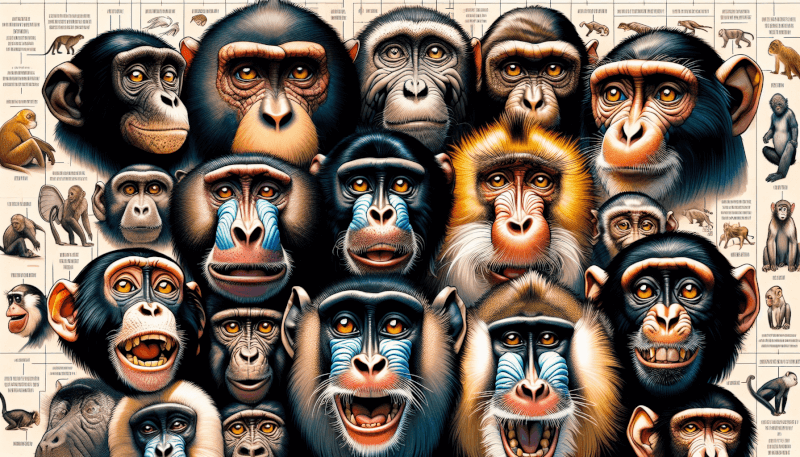In today’s world, where inclusivity and understanding are increasingly important, it is crucial to recognize and respect the diversity of emotional expression among primates. Just like humans, primates exhibit a wide range of emotions, from joy and excitement to fear and sadness. By acknowledging and valuing this variety of emotional experiences, we can foster empathy and compassion towards our primate counterparts, ultimately leading to a deeper appreciation for the complexity and richness of their lives.

The Importance of Emotional Expression in Primates
Emotions in primate societies
Emotional expression is a fundamental aspect of primate social interactions. Like humans, primates experience a wide range of emotions, including joy, fear, anger, sadness, and love. These emotions play a crucial role in their daily lives and shape their social dynamics. Just like humans communicate through language, primates communicate their emotions through various nonverbal cues, including facial expressions, body language, vocalizations, and gestures.
Emotional expression is not limited to only one or a few primate species but is observed across the primate family, including species such as chimpanzees, bonobos, gorillas, orangutans, and monkeys. Emotional expression serves as a means of conveying information, establishing social bonds, resolving conflicts, and maintaining social cohesion within primate societies.
The role of emotional communication in social bonding
One key role of emotional expression in primates is the establishment and maintenance of social bonds. Emotional communication allows individuals to express their intentions, needs, and desires to others, building trust and empathy among group members. When a primate expresses joy or happiness, it signals contentment and a positive social atmosphere, thereby encouraging cooperative behaviors and strengthening social bonds within the group.
Likewise, emotional communication can also diffuse tension or conflict within a group. For example, when a primate displays signs of fear or submission, it signals a desire to avoid conflict and maintain peaceful relationships. This expression of vulnerability can prevent aggression and promote harmony within the group.
Emotional communication in primates is not just limited to positive emotions, such as joy and love, but also includes the expression of negative emotions, such as anger or frustration. By expressing these emotions, primates can convey their displeasure, assert dominance, or establish boundaries within their social group.
Cultural Variations in Emotional Expression
Cultural differences in the display of emotions
While emotional expression is an inherent aspect of primate behavior, cultural variations exist in how emotions are expressed among different primate species. These variations reflect the influence of social and environmental factors on the development and display of emotional expressions.
For example, researchers have observed that some primate species, such as chimpanzees, have distinct regional variations in their facial expressions. These regional variations suggest the presence of cultural norms and traditions within primate groups, shaping how emotions are displayed and understood.
Cultural factors influencing emotional expression
Cultural factors, such as socialization, upbringing, and exposure to different environments, can significantly influence the way emotions are expressed among primates. Young primates learn emotional expressions by observing and imitating the behaviors of older and more experienced group members.
Additionally, the availability of resources and the level of competition within a primate society can also impact the expression of emotions. In highly competitive environments, emotions like aggression and dominance may be more prevalent, while in peaceful environments, expressions of affection and cooperation may be more common.
Understanding and respecting these cultural variations in emotional expression among primates is crucial for researchers and conservationists. It allows for a deeper understanding of primate behavior and facilitates more effective conservation efforts by considering the cultural context of these species.

Understanding Nonverbal Communication among Primates
Nonverbal cues in primate communication
Primates rely heavily on nonverbal cues to communicate emotions and intentions with one another. These nonverbal cues encompass various aspects of their behavior, including facial expressions, body language, vocalizations, and gestures.
Facial expressions, for instance, play a vital role in conveying emotions among primates. A display of bared teeth in chimpanzees can be a sign of threat or aggression, while a relaxed, open-mouthed expression can indicate a sense of calm or contentment. Similarly, wide-eyed fear expressions communicate distress or fear.
In addition to facial expressions, body language also plays a significant role in nonverbal communication among primates. Postures, such as an upright stance or a hunched-over posture, can convey dominance or submission, respectively. Additionally, gestures, such as reaching out with an open hand or extending the arm, can signal a desire for social interaction or affiliation.
Vocalizations also serve as nonverbal cues and vary across different primate species. For example, certain vocalizations in gibbons communicate territorial boundaries, while specific calls in monkeys convey warnings or alarm signals to fellow group members.
Understanding and interpreting these nonverbal cues is essential for researchers to gain insights into primate emotional expression and behavior.
Facial expressions and body language
Facial expressions and body language play a vital role in facilitating social interactions among primates. These nonverbal cues are not only important for conveying emotions but also for establishing and maintaining social hierarchies within primate groups.
Dominance hierarchies in primate societies are often determined through displays of power and submission. Facial expressions, such as aggressive or threatening stares, can be used by dominant individuals to assert their authority and establish dominance. On the other hand, submissive or fearful facial expressions communicate deference to those higher in the hierarchy.
Body language also plays a crucial role in primate social dynamics. Upright, confident postures display dominance, while slouching or submissive postures convey lower social status. By understanding these nonverbal cues, researchers can gain insights into the complex social dynamics within primate groups.
The Evolutionary Basis of Emotional Expression
Emotional expression as an adaptive mechanism
Emotional expression in primates has deep evolutionary roots and is believed to have evolved as an adaptive mechanism to enhance survival and reproductive success. Emotions and their corresponding expressions serve as crucial tools for primates to respond to their environment, interact with conspecifics, and navigate complex social relationships.
For example, the ability to express fear or distress can alert other members of a primate group to potential threats, increasing the chances of survival for the entire group. Similarly, expressions of affection and love can strengthen social bonds, leading to increased cooperation and support among group members.
Emotional expression also plays a role in mate selection and reproductive success. Displays of dominance or confidence can attract potential mates, while expressions of submission or approachability can facilitate successful mating interactions.
The link between emotions and survival
Emotions and their corresponding expressions are closely tied to survival in primate societies. Through emotional expression, primates can effectively communicate their needs, intentions, and reactions to their environment and conspecifics, thereby increasing their chances of survival.
For example, when a primate detects danger or a threat, the emotion of fear triggers physiological responses, such as increased heart rate and heightened awareness. This heightened emotional state allows the individual to respond quickly and appropriately to the threat, increasing their chances of survival.
On the other hand, emotions like joy, contentment, and love contribute to the overall well-being of primates. These positive emotions promote social cohesion, cooperation, and the formation of strong social bonds, all of which enhance the chances of survival and reproductive success.
Understanding the evolutionary basis of emotional expression helps shed light on the significance of emotions in primate societies and highlights the integral role they play in their survival and overall well-being.

Similarities and Differences Between Primate Species’ Emotional Expression
Shared emotional universals among primate species
While cultural variations exist in emotional expression among primate species, certain emotional universals can be observed across different primate groups. These shared emotions and their expressions reflect common evolutionary origins and can be traced back to a common ancestor.
For example, expressions of fear, anger, happiness, and surprise are observed in various primate species, indicating a shared emotional repertoire. These emotions, along with their corresponding facial expressions and body language, serve similar communicative functions across different primate societies.
The presence of these shared emotional universals among primate species suggests a biological basis for emotional expression, rooted in our evolutionary history.
Species-specific emotional expressions
Despite the presence of shared emotional universals, primate species also display species-specific emotional expressions. These variations can be attributed to genetic differences, ecological factors, and the specific social dynamics of each species.
For example, chimpanzees and bonobos, two closely related primate species, demonstrate different facial expressions of aggression. While both species may display bared teeth, chimpanzees have been observed to bare their lower teeth more aggressively, while bonobos predominantly display a softer, closed-mouthed facial expression.
These species-specific emotional expressions reflect adaptations to the unique social environments and ecological pressures of each primate species. By understanding these variations, researchers can gain insights into the behavioral and social dynamics specific to each species and develop more comprehensive conservation strategies.
The Role of Emotions in Primate Social Hierarchies
Emotional dynamics in primate dominance hierarchies
Primate social hierarchies, characterized by a ranking system, play a crucial role in determining power dynamics and resource allocation within a group. Emotions and their corresponding expressions play a significant role in establishing and maintaining these hierarchies.
Expressions of dominance, such as aggressive facial displays or vocalizations, are often accompanied by assertive body language and postures. Dominant individuals use these emotional displays to establish their authority and assert control over resources, including food, mates, and territory.
Furthermore, emotional expressions of submission, fear, or deference are displayed by individuals lower in the social hierarchy. These emotional displays communicate a recognition of a higher-ranking individual’s authority and help maintain social order within the group.
The influence of emotional displays on rank and status
Emotional displays have a direct impact on the rank and status of individuals within primate societies. Higher-ranking individuals often display dominant and assertive emotions, reinforcing their position of power. Conversely, lower-ranking individuals display submissive emotions, signaling their deference to individuals of higher status.
Emotional displays also influence social interactions and determine the allocation of resources within primate groups. Dominant individuals may exhibit aggression or anger to intimidate others and secure access to valuable resources. On the other hand, individuals lower in the social hierarchy may display affiliative and cooperative emotions to gain support or favor from higher-ranking individuals.
By understanding the role of emotions in primate social hierarchies, researchers can gain insights into the complex dynamics of power and dominance within these societies. This knowledge is crucial for conservationists striving to protect and preserve primate species, as well as researchers studying primate behavior and social structures.

The Impact of Environmental Factors on Emotional Expression
Effects of habitat and resource availability
Habitat and resource availability have a significant impact on the emotional expression of primates. Environmental factors, such as the abundance or scarcity of food, water, and suitable shelter, directly influence the emotional well-being of individuals within primate societies.
In environments with ample resources, individuals are more likely to display positive emotions, such as joy, contentment, and relaxation. Conversely, in resource-poor or unpredictable environments, individuals may display negative emotions, such as frustration, anxiety, and aggression.
For example, researchers have observed that primates living in fragmented habitats or regions with high human activity exhibit heightened levels of stress and anxiety. These environmental stressors can disrupt natural social structures and impact emotional expression within primate societies.
Understanding the impact of environmental factors on emotional expression is crucial for developing effective conservation strategies. By ensuring the preservation of natural habitats, promoting sustainable resource management, and minimizing human disturbances, conservationists can create environments that support the emotional well-being of primates.
Seasonal variations in emotional expression
Seasonal variations also play a role in primate emotional expression. Changes in environmental conditions, such as temperature, food availability, and daylight hours, can impact the emotional state of individuals.
For example, during times of food scarcity, primates may exhibit heightened levels of frustration or aggression as they compete for limited resources. Similarly, during mating seasons, individuals may display heightened displays of affection, attraction, or competition as they seek mates or establish mating territories.
Researchers studying primate behavior consider these seasonal variations in emotional expression when interpreting observations and data. By accounting for these variations, they can gain a more comprehensive understanding of primate emotional dynamics and the underlying factors that shape them.
The Effects of Human Interactions on Primate Emotional Expression
Impacts of captivity on emotional expression
Human interactions, particularly in captive settings, can influence primate emotional expression. When primates are kept in captivity, their natural behaviors and emotional expressions may be altered due to the unique conditions of their environment.
For example, the lack of social stimuli and natural resources in captivity can lead to boredom, frustration, and anxiety among captive primates. These negative emotions can manifest in abnormal behaviors, such as self-grooming, pacing, or rocking.
Additionally, interactions with humans in captive settings can elicit different emotional responses in primates. While some individuals may display fear or aggression towards humans, others may exhibit curiosity or even affection. These responses depend on the individual’s past experiences, exposure to humans, and the overall quality of care provided in captivity.
Conservation organizations and researchers recognize the importance of providing enriching captive environments that mimic the natural habitats and social dynamics of primates. By promoting natural behaviors and providing opportunities for social interaction, these organizations strive to support the emotional well-being of captive primates.
The role of human research and observation
Human research and observation play an essential role in understanding primate emotional expression. Researchers and scientists carefully observe and record the behaviors and emotional expressions of primates to gain insights into their social dynamics, emotions, and overall well-being.
By conducting non-invasive studies, such as behavioral observations or analysis of vocalizations and facial expressions, researchers can reveal intricate details about primate emotional expression.
Furthermore, human research and observation also contribute to conservation efforts by providing valuable insights into the behaviors and needs of primate species. By understanding the emotional expression of primates, researchers can better inform conservation strategies, habitat preservation, and wildlife management practices.
Ethical Considerations in Researching Primate Emotional Expression
Invasive research techniques and ethical concerns
While understanding primate emotional expression is vital for scientific knowledge and conservation efforts, it is essential to consider the ethical implications of certain research techniques. Invasive research methods that may cause harm, induce stress, or disrupt the natural behavior of primates should be avoided.
Researchers must prioritize non-invasive observation and data collection methods to minimize any potential negative impact on individual primates or their social groups. This approach ensures that the research contributes to scientific knowledge while upholding the well-being and welfare of the studied primates.
Balancing scientific knowledge with animal welfare
The study of primate emotional expression requires a delicate balance between scientific knowledge and animal welfare considerations. It is crucial for researchers to prioritize the emotional well-being and welfare of primates, while still pursuing scientific goals.
Methods such as long-term field studies, non-invasive observation, and behavioral analysis can provide valuable insights into primate emotional expression without causing harm or distress to the studied individuals. Researchers should also work closely with conservation organizations, ethical review boards, and animal welfare experts to ensure the ethical conduct of research.
Ultimately, by striking a balance between scientific knowledge and animal welfare, researchers can contribute to a deeper understanding of primate emotional expression while working towards the conservation and protection of these incredible species.
Conclusion
Understanding and respecting the diversity of emotional expression among primates is crucial for comprehending their behaviors, social dynamics, and overall well-being. Emotional expression plays a fundamental role in primate societies, serving as a means of communication, establishing social bonds, and maintaining social hierarchies.
Cultural variations in emotional expression exist among primate species, shaped by socialization, environmental factors, and regional traditions. Recognizing and understanding these variations are essential for research and conservation efforts.
Nonverbal cues, such as facial expressions and body language, are integral to primate emotional expression. Through these nonverbal cues, primates convey their emotions, assert dominance, and navigate complex social relationships.
The evolutionary basis of emotional expression reflects its adaptive nature, enhancing survival and reproductive success among primates. Emotions play a central role in the formation of social bonds, mate selection, and the establishment of dominance hierarchies.
While shared emotional universals exist among primate species, there are also species-specific emotional expressions. These variations reflect the genetic, ecological, and social influences on emotional expression.
Emotions are closely tied to social hierarchies in primate societies, with emotional displays playing a significant role in determining rank and status. Understanding the impact of emotions on social hierarchies provides insights into power dynamics and social cohesion within primate groups.
Environmental factors, such as habitat quality and resource availability, impact emotional expression among primates. Additionally, seasonal variations influence the emotional state of individuals and their social interactions.
Human interactions, particularly in captivity, can influence primate emotional expression. Providing enriching captive environments and minimizing stressors is crucial for maintaining the emotional well-being of captive primates.
Researching primate emotional expression requires ethical considerations to ensure the welfare of individuals while advancing scientific knowledge. Non-invasive research methods should be prioritized, and a balance must be struck between scientific goals and animal welfare.
In conclusion, respecting the diversity of emotional expression among primates is essential not only for understanding their behaviors and social dynamics but also for implementing effective conservation strategies. By recognizing the importance of emotional expression, we can continue to appreciate and protect these extraordinary creatures.


